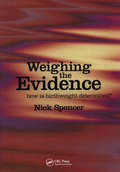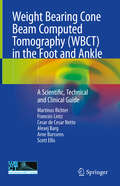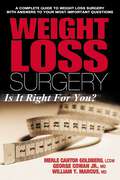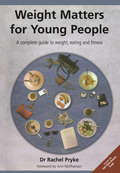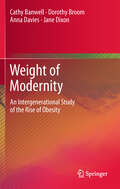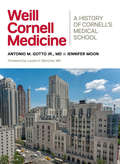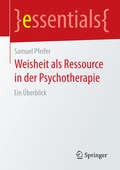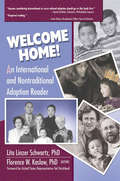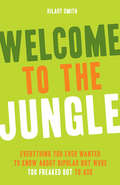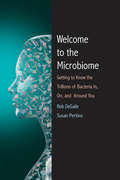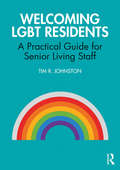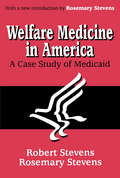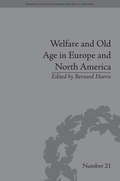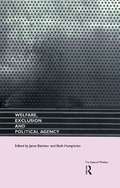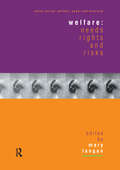- Table View
- List View
Weighing the Evidence: How is Birthweight Determined?
by Nick SpencerRationalization is concerned with making the most effective use of the resources available. In many places where this process is taking place it is plagued with public opposition and misunderstanding. Hitherto rationalization in the acute care sector has primarily been concerned with closing sites closing beds moving beds between services and moving beds from one site to another. This book discusses the need for rationalization in the context of health service reforms and future strategy. It considers recent changes in the health service the case for rationalization health care needs the role of public relations the future of the acute care hospital site and facilities appraisal and the costs of rationalization. The text is essential reading for managers and clinicians involved in acute care services non-executive members of boards and trusts and students of health services management.
Weighing the Options: Criteria for Evaluating Weight-Management Programs
by Paul R. ThomasNearly one out of every three adults in America is obese and tens of millions of people in the United States are dieting at any one time. This has resulted in a weight-loss industry worth billions of dollars a year and growing. What are the long-term results of weight-loss programs? How can people sort through the many programs available and select one that is right for them? Weighing the Options strives to answer these questions. Despite widespread public concern about weight, few studies have examined the long-term results of weight-loss programs. One reason that evaluating obesity management is difficult is that no other treatment depends so much on an individual's own initiative and state of mind.Now, a distinguished group of experts assembled by the Institute of Medicine addresses this compelling issue. Weighing the Options presents criteria for evaluating treatment programs for obesity and explores what these criteria mean--to health care providers, program designers, researchers, and even overweight people seeking help.In presenting its criteria the authors offer a wealth of information about weight loss: how obesity is on the rise, what types of weight-loss programs are available, how to define obesity, how well we maintain weight loss, and what approaches and practices appear to be most successful.Information about weight-loss programs--their clients, staff qualifications, services, and success rates--necessary to make wise program choices is discussed in detail.The book examines how client demographics and characteristics--including health status, knowledge of weight-loss issues, and attitude toward weight and body image--affect which programs clients choose, how successful they are likely to be with their choices, and what this means for outcome measurement. Short- and long-term safety consequences of weight loss are discussed as well as clinical assessment of individual patients.The authors document the health risks of being overweight, summarizing data indicating that even a small weight loss reduces the risk of disease and depression and increases self-esteem. At the same time, weight loss has been associated with some poor outcomes, and the book discusses the implications for program evaluation.Prevention can be even more important than treatment. In Weighing the Options, programs for population groups, efforts targeted to specific groups at high risk for obesity, and prevention of further weight gain in obese individuals get special attention.This book provides detailed guidance on how the weight-loss industry can improve its programs to help people be more successful at long-term weight loss. And it provides consumers with tips on selecting a program that will improve their chances of permanently losing excess weight.
Weight Bearing Cone Beam Computed Tomography (WBCT) in the Foot and Ankle: A Scientific, Technical and Clinical Guide
by Scott Ellis Martinus Richter Francois Lintz Alexej Barg Arne Burssens Cesar de Cesar NettoThis scientific, technical and clinical guide to Weight Bearing Cone Beam Computed Tomography (WBCT), written by the board of the International WBCT Society, presents all of the relevant content to date on the development, implementation, interpretation and clinical application of WBCT for the foot and ankle. Part One describes the history of the development of, and need for, WBCT as an imaging option and a scientific overview of the procedure. Part Two is an exhaustive scientific background, comprised of 16 landmark studies, describing its advantages for selected foot and ankle injuries and deformities (both congenital and acquired). With this science as context, Part Three includes chapters on the technical aspects and necessary background for WBCT, introduces the different devices, and provides insight into the actual measurement possibilities, including the initial software solutions for automatic measurements. Current clinical applications via case material are illustrated in atlas-like fashion in the next chapter, and a final chapter on future developments explores further applications of WBCT, such as dynamic scans and measurements or hologram-like visualization.The first book publication of its kind on this exciting and developing imaging modality, Weight Bearing Cone Beam Computed Tomography (WBCT) in the Foot and Ankle will be an excellent resource for orthopedic and foot and ankle surgeons, radiologists, and allied medical professionals working in this clinical area.
Weight Bias in Health Education: Critical Perspectives for Pedagogy and Practice
by Heather A. Brown Nancy Ellis-OrdwayWeight stigma is so pervasive in our culture that it is often unnoticed, along with the harm that it causes. Health care is rife with anti-fat bias and discrimination against fat people, which compromises care and influences the training of new practitioners. This book explores how this happens and how we can change it. This interdisciplinary volume is grounded in a framework that challenges the dominant discourse that health in fat individuals must be improved through weight loss. The first part explores the negative impacts of bias, discrimination, and other harms by health care providers against fat individuals. The second part addresses how we can ‘fatten’ pedagogy for current and future health care providers, discussing how we can address anti-fat bias in education for health professionals and how alternative frameworks, such as Health at Every Size, can be successfully incorporated into training so that health outcomes for fat people improve. Examining what works and what fails in teaching health care providers to truly care for the health of fat individuals without further stigmatizing them or harming them, this book is for scholars and practitioners with an interest in fat studies and health education from a range of backgrounds, including medicine, nursing, social work, nutrition, physiotherapy, psychology, sociology, education and gender studies.
Weight Loss Surgery
by Merle Cantor Goldberg George, Jr. Cowan William Y. MarcusFor the thousands of people affected by severe obesity, the decision to undergo weight loss surgery can be a matter of life and death. But it is not a simple procedure, and once done, it produces life-altering changes. To help you make the best possible choice, a dynamic team of experts has come together to share their experience, knowledge, and findings about weight loss surgery. Merle Cantor Goldberg is a leading psychotherapist specializing in eating disorders; Drs. Marcus and Cowan have helped develop many of the techniques used in bariatric surgery.Weight Loss Surgery first addresses important questions about your qualification for this type of surgery, as well as the various surgical options available. It then presents acomprehensive overview of pre-op visits and the post-op recovery period, examining both the psychological and the physical impacts of surgery.
Weight Loss for Life: The Proven Plan for Success (A Johns Hopkins Press Health Book)
by Lawrence J. Cheskin Kimberly A. GudzuneThis is not a fad diet book. This is the most comprehensive, scientifically based program to lose weight and keep it off, with practical details about diet and nutrition, movement and motivation, medications, supplements, surgery, and more.In Weight Loss for Life, two experts from the Johns Hopkins Healthful Eating, Activity & Weight Program provide you with all of the information you need on your weight loss journey. They bring together leading experts in behavioral health, nutrition, exercise, and nursing to help you develop a plan that works best for you—and that's not focused on just restricting calories or certain foods. Anyone struggling with unwanted weight gain or obesity will find this program to be helpful, compassionate, and clear. A central feature of the program is a Personal Plan of Action to help you set up reachable goals, plan your meals, and make time for movement. All the recommendations are customizable based on your personal health and needs. You'll enjoy the interactive features, too, with surveys throughout asking you to reflect on your own eating habits as well as barriers to success. And unlike other works on the market, Weight Loss for Life covers it all: supplements, prescription medications, med spas, and surgical options. If you struggle, it can help you get back on track. Throughout, testimonials from others who have followed the program along with hundreds of photographs and drawings will help educate and keep you motivated along your weight loss journey. Weight Loss for Life is the guide to the science and art of achieving and maintaining a healthful weight.
Weight Management: State of the Science and Opportunities for Military Programs
by Subcommittee on Military Weight ManagementThe primary purpose of fitness and body composition standards in the U.S. Armed Forces has always been to select individuals best suited to the physical demands of military service, based on the assumption that proper body weight and composition supports good health, physical fitness, and appropriate military appearance. The current epidemic of overweight and obesity in the United States affects the military services. The pool of available recruits is reduced because of failure to meet body composition standards for entry into the services and a high percentage of individuals exceeding military weight-for-height standards at the time of entry into the service leave the military before completing their term of enlistment. To aid in developing strategies for prevention and remediation of overweight in military personnel, the U.S. Army Medical Research and Materiel Command requested the Committee on Military Nutrition Research to review the scientific evidence for: factors that influence body weight, optimal components of a weight loss and weight maintenance program, and the role of gender, age, and ethnicity in weight management.
Weight Matters for Young People: A Complete Guide to Weight, Eating and Fitness
by Rachel PrykeOfficial publication of Obesity Awareness Week 2006 If only weight didn't matter to young people! But it does - and, in reality, it should. So how can today's youngsters overcome the relentless hype to look like a cool stick insect and combat the enormous pressure from the food industry to eat vast quantities of junk? What can families do to help a teenager that has low self esteem or may even be struggling with an eating disorder? Weight Matters for Young People takes an in depth look at how young people can assume responsibility for their own health, ranging from the various factors that influence teenage decisions right through to practical nutrition. The TOP teen Health Plan assesses the strengths and weaknesses of current lifestyle, whilst the Food Frequency Framework solves family meal dilemmas. Common dieting regimes are assessed to see which are safe or worthwhile, there is a chapter on eating disorders and finally an A to Z of common weight-related conditions. Weight Matters for Young People is a complete reference book that will put young people confidently in charge of their own health. Health workers will find safe, evidence-based nutritional information plus answers to common weight-related queries and plenty of further resources.
Weight of Modernity
by Anna Davies Cathy Banwell Jane Dixon Dorothy BroomOver a half of adults in the US, Canada, Australia and numerous European countries are now overweight or obese, a proportion that has risen sharply in the past two decades. Dominant biomedical explanations focus on the energy equation - an imbalance between energy intake and expenditure - and remedies focus on motivating individuals to restore the balance by eating better and being more active, or - in extreme cases - surgical intervention. This book offers a perspective that sees increasing obesity as a social phenomenon as well as a public health problem. It contains detailed accounts of three generations of Australians' experiences of changing environments and the emergence of social trends such as increasing availability of convenience foods, the individualisation and commercialisation of leisure, car reliance, and busyness. Participants' narratives are interwoven with sociological and historical analyses of changes to show how contemporary Australians are experiencing and adapting to dramatic socio-cultural and environmental changes that are reshaping their lives and, in many cases, their bodies. The book demonstrates that obesity is an unintended consequence of economic development accompanied by profound socio-cultural changes, and by identifying the key developments the authors propose leverage points. While the research was conducted in Australia, the fundamental drivers of rapid weight gain are equally present in other modern, secular societies.
Weighted Network Analysis
by Steve HorvathHigh-throughput measurements of gene expression and genetic marker data facilitate systems biologic and systems genetic data analysis strategies. Gene co-expression networks have been used to study a variety of biological systems, bridging the gap from individual genes to biologically or clinically important emergent phenotypes.
Weighty Problems: Embodied Inequality at a Children’s Weight Loss Camp
by Laura BackstromMany parents, teachers, and doctors believe that childhood obesity is a social problem that needs to be solved. Yet, missing from debates over what caused the rise in childhood obesity and how to fix it are the children themselves. By investigating how contemporary cultural discourses of childhood obesity are experienced by children, Laura Backstrom illustrates how deeply fat stigma is internalized during the early socialization experiences of children. Weighty Problems details processes of embodied inequality: how the children came to recognize inequalities related to their body size, how they explained the causes of those differences, how they responded to micro-level injustices in their lives, and how their participation in a weight loss program impacted their developing self-image. The book finds that embodied inequality is constructed and negotiated through a number of interactional processes including resocialization, stigma management, social comparisons, and attribution.
Weill Cornell Medicine: A History of Cornell’s Medical School
by Antonio M. Gotto Jr. Jennifer Moon Laurie H. GlimcherWeill Cornell Medicine is a story of continuity and transformation. Throughout its colorful history, Cornell's medical school has been a leader in education, patient care, and research—from its founding as Cornell University Medical College in 1898, to its renaming as Weill Cornell Medical College in 1998, and now in its current incarnation as Weill Cornell Medicine. In this insightful and nuanced book, dean emeritus Antonio M. Gotto Jr., MD, and Jennifer Moon situate the history of Cornell's medical school in the context of the development of modern medicine and health care. The book examines the triumphs, struggles, and controversies the medical college has undergone. It recounts events surrounding the medical school’s beginnings as one of the first to accept female students, its pioneering efforts to provide health care to patients in the emerging middle class, wartime and the creation of overseas military hospitals, medical research ranging from the effects of alcohol during Prohibition to classified partnerships with the Central Intelligence Agency, and the impact of the Depression, 1960s counterculture, and the Vietnam War on the institution. The authors describe how the medical school built itself back up after nearing the brink of financial ruin in the late 1970s, with philanthropic support and a renewal of its longstanding commitments to biomedical innovation and discovery.Central to this story is the closely intertwined, and at times tumultuous, relationship between Weill Cornell and its hospital affiliate, now known as New York–Presbyterian. Today the medical school’s reach extends from its home base in Manhattan to a branch campus in Qatar and to partnerships with institutions in Houston, Tanzania, and Haiti. As Weill Cornell Medicine relates, the medical college has never been better poised to improve health around the globe than it is now.
Weimar Institute's NEWSTART® Lifestyle Cookbook: More Than 260 Heart-Healthy Recipes Featuring Whole Plant Foods
by Sally J. Christenson Frances De VriesMORE THAN 260 HEART-HEALTHY RECIPES FEATURING WHOLE PLANT, FOODS
Weiner's Pain Management: A Practical Guide for Clinicians
by Mark V. Boswell B Eliot ColeThis seventh edition of a bestseller has been totally revised and updated, making this the most comprehensive rewrite in the book's long and distinguished history. It includes new chapters, new sections and section editors, and new contributors. Offering an interdisciplinary approach to pain management, the book delivers a scholarly presentation for those concerned with pedagogy, while still being accessible to those concerned with the immediate application of techniques.
Weisheit als Ressource in der Psychotherapie: Ein Überblick (essentials)
by Samuel PfeiferSamuel Pfeifer gibt einen Überblick über verschiedene Weisheitsmodelle und entwirft ein didaktisches Basismodell der Weisheit von Empathie, Kontextualismus, Zeitperspektive und Werthaltungen. Einer biologistischen personalisierten Psychiatrie steht eine personzentrierte Haltung gegenüber. Effektive Therapie zeigt erstaunlich viele Parallelen zu grundlegenden Tugenden der Weisheit. Als Therapiekonzept können Weisheitskompetenzen als Psychoedukation bei psychischen Störungen vermittelt werden. Weisheit ist aber auch eine persönliche Grundhaltung der Balance in der eigenen Existenz. Dieses Essential schlägt einen Bogen von alten Weisheitsquellen zu aktueller Praxis in helfenden Berufen. Über die letzten 30 Jahre wurde an verschiedenen Zentren intensiv zur psychologischen Bedeutung von Weisheit geforscht. Weisheit wird dabei auf ihre historischen, spirituellen und philosophischen Wurzeln zurückverfolgt, dann aber auch in aktueller Form für die Psychologie unserer Zeit relevant gemacht.
Welcome Home to Ivy Falls: The small town, second chance romance that will win your heart (Ivy Falls)
by Amy TrueDoesn’t everyone deserve their happy-ever-after? Piper Townsend is working hard to build her new life in Ivy Falls but fears she will never escape her past reputation. When Dr Crawford ‘Ford’ Foster breezes into town they recognise each other from a dark time in Piper’s life and she resolves to avoid him. But Ivy Falls is a small town, and with Ford covering for the local doctor for the whole summer, their paths keep crossing. Despite herself, PIper feels a chemistry she has never known before. Perhaps she could take a chance, just for the summer? But can Ford find his way into Piper’s heart and is she ready to trust in love? An irresistible small-town romance that fans of Jessica Redland and Laurie Gilmore will adore. Praise for Amy True: ‘A terrific read, full of sassy characters, some spice and two excellent leads …There’s a wonderful sense of place and community in small-town Ivy Falls, and I can’t wait to return and find out what Amy has in store for the series.’ Suzanne Snow ‘A heart-tugging and addictive second-chance romance brimming with secrets, painful history, and small-town charm.’ Kelly Siskind, author of New Orleans Rush ‘Beautiful and heartfelt - I fell in love with the people of Ivy Falls and how love restored all the broken things in this second chance romance.’ Jennifer Ryan – New York Times Bestselling Author ‘Amy True’s debut is an expertly crafted romance that will break your heart then carefully mend it, stronger than it was before. Torran and Beck’s romance will captivate you and will leave you desperately longing to return to Ivy Falls.’ Jennifer Hennessy, author of Degrees of Engagement. ‘Warm and exquisite…each character is written with captivating depth. Because Amy True writes with such care, you know when you are immersed in her story and your heart is breaking, that the characters will be all right—and so will you. I’m already looking forward to the next book in this series!’ Annette Christie ‘You’ll do more than meet in Ivy Falls when you read this adorably sweet, poignantly funny novel from Amy True. With laugh-out-loud humour…and beautiful writing, Meet Me In Ivy Falls pulls at…your heartstrings while making you root for Tor and Beck to finally get their hard-earned happily ever after.’ Sophie Sullivan ‘A beautiful tale of second chances, new beginnings, and the heartstopping, unmistakable magic of first loves. I adored this book and fell hard for Beck, Torran, and the entire town of Ivy Falls.’ Amy Pine Readers are falling hard for Ivy Falls: ‘This story gave me all the feels…You will laugh and cry during this book.’***** Reader Review ‘I have been sucked into the world of Ivy Falls and I never want to leave!…I cannot wait to see what comes next.’***** Reader Review ‘A comforting and engaging read. Perfect for fans of emotional, small-town romances.’***** Reader Review
Welcome Home!: An International and Nontraditional Adoption Reader
by Florence Kaslow Lita Linzer SchwartzExamine the pros and cons of nontraditional adoption! Welcome Home! An International and Nontraditional Adoption Reader is an essential guide to the process, pros, and cons of adopting children from outside the United States, with special needs, and/or from a different racial/cultural background. The book documents every aspect of the adoption procedure-from working with "facilitators," adoption agencies, and attorneys to mixed reactions over a child&’s possible loss of heritage as the result of a transracial or multicultural adoption. Parents and adoptees offer unique, firsthand perspectives on the cautions and benefits of nontraditional adoption. Americans adopted more than 20,000 children from other countries in 2001, a number that reflects humanitarian motives, the desire to adopt a child from a specific country, and/or frustration with the domestic adoption system. Including a foreword by United States Representative Ted Strickland, Welcome Home! is a practical resource for anyone thinking of establishing a family or adding to their own. The book provides insight into the adoption process, open adoption, biracial adoption, adopting a special needs child, cultural attitudes, and how to handle an adopted child&’s questions in later years. It also addresses specific adoption issues, including: how to verify an agency&’s credentials; how an agency negotiates with the birth mother; state and country laws and practices; tax benefits; and expenses, including legal and medical costs; and includes research findings on the Northeast-Northwest Collaborative Adoption Projects (N2CAP) Welcome Home! tells the stories of: Naomi and Fred, an intermarried couple (she&’s Jewish, he&’s not) who adopted a Greek baby in 1962 "Tina" and "Lee," a lesbian couple, who adopted a baby from China Marianne, a professor of child and adolescent psychiatry at the University of Lund in Sweden, who adopted babies from Iran and Thailand-several years after her divorce Pamela, a divorced mother of four biological children who has adopted babies from Viet Nam and China All of her biological children Mildred-Pamela&’s mother and the children&’s grandmother Karen, adoptive mother and national chairperson for Families for Russian and Ukrainian adoption (FRUA) William, adoptive father of miracle sisters from Romania and many more! Welcome Home! is an invaluable source of unusual insight for psychologists, psychiatrists, marriage and family therapists, adoption agencies, counselors, social workers, attorneys, physicians, academics, and, of course, anyone considering adoption.
Welcome to the Jungle: Everything You Wanted to Know about Bipolar But Were Too Freaked Out to Ask
by Hilary SmithA Bipolar Guide from a Bipolar PersonWelcome to the Jungle has a greater focus on bipolar people, not the diagnosis: the ways in which each person can find his or her own way through the extreme emotional states and intense experiences that we are calling “bipolar”—whether that means medication or meditation, psychiatrists or vision quests, good sleep or good all-night dancing, or a little bit of everything.An honest, relatable book that can help you figure out how to live your life with bipolar disorder. Many bipolar books are too clinical, too alarmist, and too clearly written for family members and caretakers of people diagnosed with this mood disorder. Welcome to the Jungle is different. Author Hilary Smith wrote this guide because it is the book she wishes she'd been given when she was first diagnosed with bipolar disorder. It answers questions, points to resources, and most of all, comes from someone who understands what it’s like to be thrown off course by an overwhelming mental health issue—and what to do afterwards.Know that you are not alone—and that many paths can lead to healing. Just like for everyone else, there are many, many paths that bipolar people can take in life. Learn more about how to live your own life with a mental illness using the help of the insights in Welcome to the Jungle, which covers topics such as:Wrapping your head around triggers, causes of mood swings, medications, and therapistsRecovering from mental breakdowns, manic moments, and major depressive episodesLiving your life beyond the diagnosis—and helping your family to do the sameReaders of bipolar mental health books like The Bipolar Workbook, Rock Steady, or OMG That's Me! will love the devastatingly on-target, honest insights offered in Welcome to the Jungle.*This book is not intended to diagnose, treat, or prevent any illness or act as a substitute for advice from a doctor or psychiatrist.*
Welcome to the Microbiome
by Rob Desalle Patricia J. Wynne Susan L. PerkinsSuddenly, research findings require a paradigm shift in our view of the microbial world. The Human Microbiome Project at the National Institutes of Health is well under way, and unprecedented scientific technology now allows the censusing of trillions of microbes inside and on our bodies as well as in the places where we live, work, and play. This intriguing, up-to-the-minute book for scientists and nonscientists alike explains what researchers are discovering about the microbe world and what the implications are for modern science and medicine. Rob DeSalle and Susan Perkins illuminate the long, intertwined evolution of humans and microbes. They discuss how novel DNA sequencing has shed entirely new light on the complexity of microbe-human interactions, and they examine the potential benefits to human health: amazing possibilities for pinpoint treatment of infections and other illnesses without upsetting the vital balance of an individual microbiome. This book has been inspired by an exhibition, The Secret World Inside You: The Microbiome, at the American Museum of Natural History, which will open in New York in early November 2015 and run until August 2016. It will then travel to other museums in the United States and abroad.
Welcoming LGBT Residents: A Practical Guide for Senior Living Staff
by Tim R. JohnstonWelcoming LGBT Residents is the first comprehensive guide to working with LGBT older adults in senior living settings. The LGBT older adult population represents one of the fastest-growing subpopulations within our aging society. Despite the increasing demand for LGBT-affirming services there is an absence of training books for care providers. This dual-purpose text is appropriate for training and as a guide to answer questions that may come up during daily tasks. It is based on the most recent research and includes stories and testimonials from LGBT older adults and providers in the field. Chapters include: LGBT-inclusive intake and conversations; Gender identity and expression; Memory care and LGBT people; Navigating family dynamics; Addressing conflict between residents; Staff opinions, beliefs, and training. This timely book will be of interest to professional care providers, from long-term care nurses and assisted living administrators to staff in retirement communities, as well as students in gerontology, health care administration, and social work courses.
Welfare Medicine in America: A Case Study of Medicaid
by Rosemary A. StevensThe present study was undertaken for three reasons: Medicaid is a vital program-in the early 1970s it provided care for over one tenth of the American population. It is a huge program-in the same period it consumed over nine billion dollars of public funds. And Medicaid is, in many ways, the most direct involvement with the provision of medical care undertaken by either the federal government or the states. But until the publication of this book, Medicaid had not been studied in depth or in a systematic way. Welfare Medicine in America is the complete history of Medicaid. The authors carefully examine the program's historical antecedents, its strengths, and its weaknesses. In part one, "The Coming of Medicaid," the hows and whys of the establishment of Medicaid are discussed, as are the basic provisions of the program. In part two, "The Euphoric Demise: July 1965-January 1968," the focus is on how Medicaid is administered in the states. In part three, "The Storm: January 1968-July 1970," specific amendments to Medicaid, the costs involved, and other health programs are examined. And in part four, "Benign Neglect: July 1970-June 1973," the role of the courts in administering Medicaid, and its future, are the primary subjects. This history of Medicare, however, goes beyond the specific government program itself and offers a paradigm for inquiring into the problems of medical care in general and the nature and limitations of public medical services. Welfare Medicine in America is a profound analysis of Medicaid and welfare systems, and will be of great use to policymakers, students of welfare and government, and to those working within the medical profession.
Welfare Rights and Social Policy
by Hartley DeanWelfare Rights and Social Policy provides an introduction to social policy through a discussion of welfare rights, which are explored in historical, comparative and critical context. At a time when the cause of human rights is high on the global political agendathe authorasks why the status of welfare rights as an element of human rights remains ambiguous. Rights to social security, employment, housing, education, health and social care are critical to human well-being. Yet they are invariably subordinate to the civil and political rights of citizenship, they are often fragile and difficult to enforce, and because of their conditional nature they may be implicated in the social control of individual behaviour.
Welfare and Old Age in Europe and North America: The Development of Social Insurance (Perspectives in Economic and Social History #21)
by Bernard HarrisOver the last twenty years, historians have become increasingly interested in the role of non-state organizations in the development of welfare services. This study is particularly focused on the role of friendly societies and other insurance bodies in the provision of aid for the elderly and the sick.
Welfare, Exclusion and Political Agency
by Janet Batsleer Beth HumphriesWelfare, Exclusion and Politcal Agency develops key topics in social work and social policy relating to exclusion, social divisions and control in welfare. It provides theoretical tools for students, academics and professionals whose work involves them in supporting the political agency of excluded groups. At a time when there have been profound shifts in the organization of welfare and the underpinning theories of the associated professions, the book tackles issues such as: *the move away from publicly funded welfare *the loss of a public service ethic *reduction of input from professionals in policy *loss of professional skills *increase of bureaucracy.
Welfare: Needs, Rights and Risks (Social Policy: Welfare, Power and Diversity)
by Mary LanganWelfare: Needs, Rights and Risks addresses the question of how people get access to social welfare in the UK today. It explores the public, political and professional definitions, constructions and conflicts about who should receive social welfare and under what conditions. In a period during which the rationing, targeting and selective provision of welfare have become more significant, more visible and more disputed, this book examines how individuals and groups come to be defined as in need, at risk or deserving of welfare.
